#study after Velazquez's portrait of pope innocent x
Photo
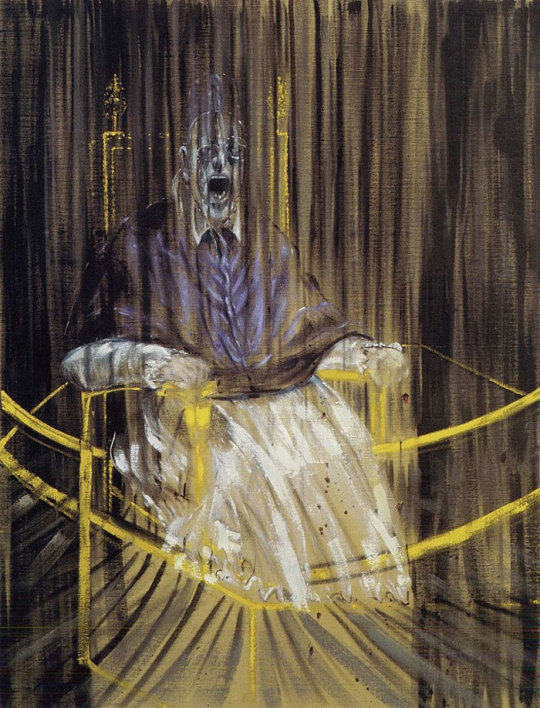
Study After Velázquez's Portrait Of Pope Innocent X
Artist: Francis Bacon | Year (completed): 1953 | Style: Expressionism
In 1649, Pope Innocent X commissioned Velázquez to paint his portrait. Many artists and critics deem Portrait of Innocent X the finest portrait ever created. Velázquez, however, did not flatter his subject or try to showcase him in a better light. The Pope's portrait is renowned for its realism. It honestly portrays a highly educated, cunning, but aging man. Despite seeing it just once, Francis Bacon used Velázquez's painting as the source material. It’s important to note that Bacon never painted from life and preferred to use various visual sources, such as commissioned and found paintings. In Study After Velázquez's Portrait Of Pope Innocent X, Bacon could paint the Pope in an even less favorable manner than Velázquez did. In Bacon's interpretation, the Pope is depicted screaming, but the enclosing draperies and the deep, dark colors seem to "hush" his voice. The dark background hues give the picture a horrible and nightmare-like tone. Bacon's response to why he kept returning to Velázquez's portrait was that he had nothing against popes and was only looking for "an excuse to use these colours."
#francis bacon#artist#art#expressionism#pope innocent x#velazquez#portrait#study after velazquez's portrait of pope innocent x
105 notes
·
View notes
Text

Study after Velázquez's Portrait of Pope Innocent X - Francis Bacon 1953
#francis bacon#art#study after Velazquez's portrait of pope innocent x#modern art#master piece#gothic#horror art
5 notes
·
View notes
Text

STUDY AFTER VELÁZQUEZ’S PORTRAIT OF POPE INNOCENT X (1953)by FRANCIS BACON
Inspired by DIEGO VELAZQUEZ’S "PORTRAIT OF INNOCENT X," FRANCIS BACON expressed his atheistic point of view by reinterpreting elements of the original painting to create his own version. Although BACON claims that this painting was simply a “excuse” to experiment with different colours, there has to be a deeper meaning behind creating such an intimidating piece.
The dark colours are the main focal point of this painting, along with the menacing face of the Pope in the painting. Although BACON did not explicitly state his reasons for creating this work, it can be inferred that his atheism is what motivated him.
Through the demonized face of the so-called “Pope”, we can see that BACON was challenging some of the tenets of religion. While most of BACON'S work consists of darker colors, the use of gold can be interpreted as an emphasis on something else.The color palette, being mainly black, purple, and white, is used to emphasize a negative theme.
The expression on the Pope's face suggests that he is going to cry out in pain. Using the Pope's face, BACON may be suggesting that the Pope is an example of corruption caused by the very existence of God, based on how the Pope is portrayed as inhumane.
In addition to the Pope's demon form, BACON places the Pope's body atop a golden chair. Gold is often associated with sanctity and truth. BACON may be suggesting that a world without GOD is the true reality of the world, and instead of worshipping GOD, worshipping truth is more important
#study after Velázquez’s Portrait of Pope Innocent X#Francis Bacon#diego velazquez#expressionism#expressionism artist
1 note
·
View note
Text
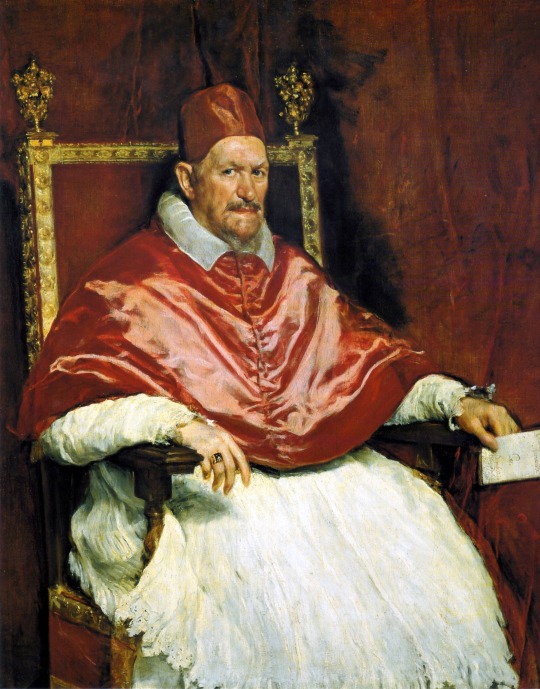
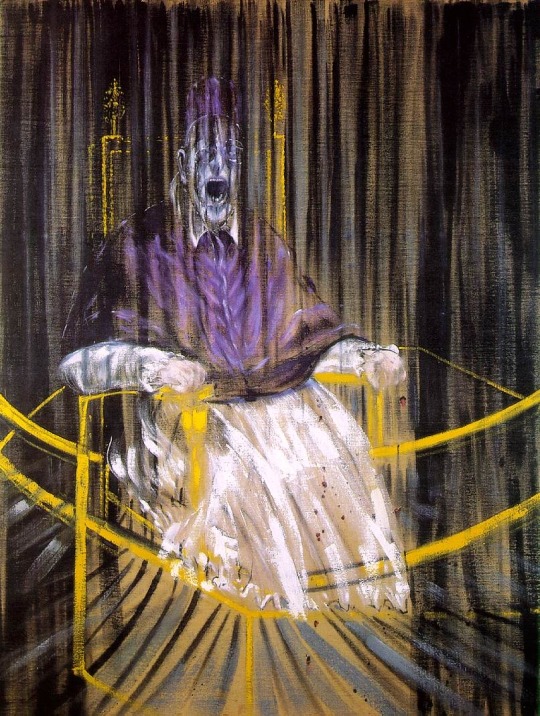
Diego Velázquez, Portrait of Pope Innocent X, 1650
Francis Bacon, Study After Velazquez's Portrait of Pope Innocent X, 1953
#diego velázquez#francis bacon#spanish painter#british painter#british art#british painting#modern art#art history#aesthetictumblr#screaming pope#tumblraesthetic#tumblrpic#tumblrpictures#tumblr art#tumblrstyle#aesthetic#artists on tumblr#tumblrposts#beauty
250 notes
·
View notes
Text


Study after Velazquez's Portrait of Pope Innocent X, Francis Bacon, 1953. (Side by side for comparison. I think it's a good likeness).
I get it, man. Popes are fucking scary.
Just be glad you aren't a choir boy.
Happy Halloween.
9 notes
·
View notes
Photo
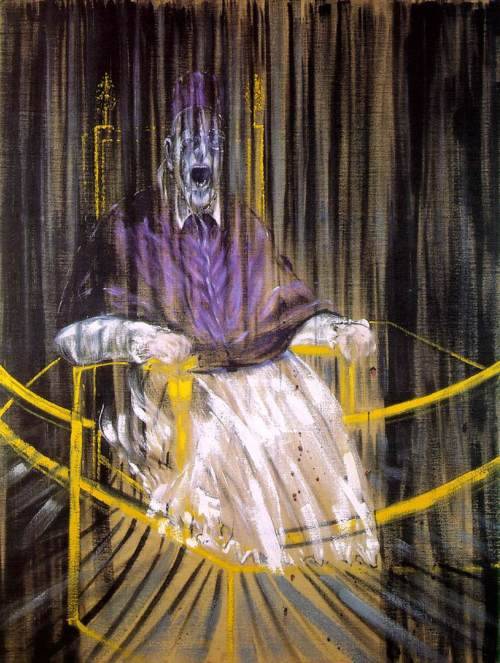
Francis Bacon, Study after Velazquez's Portrait of Pope Innocent X, 1953
10 notes
·
View notes
Text
Francis Bacon Papal Portraits of 1953.
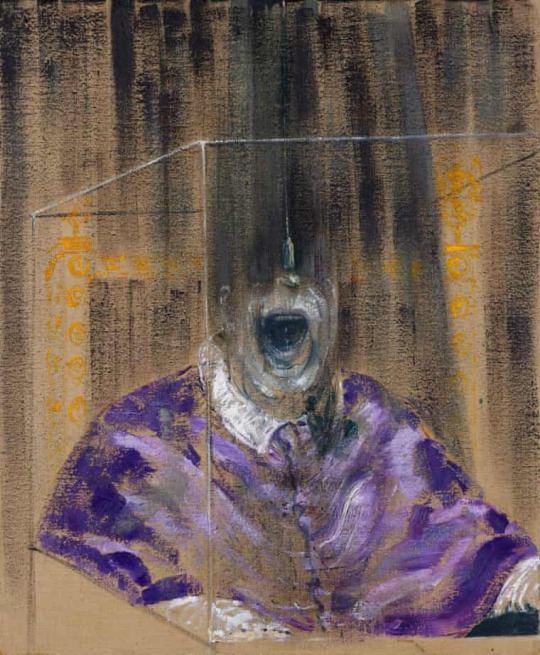
Throughout his long career, Francis Bacon (1909‑1992) steadfastly focused on the human figure as the subject of his paintings. Unlike other major artists of his time who reveled in abstraction, such as Jackson Pollock and Barnett Newman, Bacon never deviated from his commitment to making images of people. Yet while extending the timeless tradition of figuration, he invented profound and startling new ways of portraying people as he distorted the inhabitants of his painterly world in order to ‘unlock the valves of feeling and therefore return the onlooker to life more violently.’
Bacon’s most recognizable image, and hence most famous painting, is the screaming pope of Study after Velázquez’s Portrait of Pope Innocent X, 1953. The picture was inspired by Diego Velázquez’s extraordinarily lifelike portrait of a powerful and unscrupulous pope who duplicitously took the name Innocent. Painted in 1650 at the height of the Baroque period, shortly after his arrival in Rome from Spain, it was Velázquez’s eminently successful attempt to rival the portraiture of Titian and the great painters of Italy. The subject of the painting is arguably the most powerful man in the world. He sits confidently on the papal throne, fully at ease ex cathedra—literally, from the cathedral seat—as God’s representative on earth.

The true brilliance of Velázquez’s accomplishment in this painting is to have satisfied his demanding papal client with a flattering, beautifully rendered portrait while at the same time passing on for the ages the unmistakable hint of corrupt character and deep‑seated deceit behind that well‑ordered and stern façade.
‘Haunted and obsessed by the image…by its perfection,’ Bacon sought to reinvent Velázquez’s Portrait of Pope Innocent X in the papal portraits that form the focus of this book. In the great painting from the Des Moines Art Center, the Study after Velazquez’s Portrait of Pope Innocent X, Bacon updates the seventeenth‑century image by transforming the Spanish artist’s confident client and relaxed leader into a screaming victim. Trapped as if manacled to an electric chair, the ludicrously drag‑attired subject is jolted into involuntary motion by external forces or internal psychoses. The eternal quiet of Velázquez’s Innocent is replaced by the involuntary cry of Bacon’s anonymous, unwitting, tortured occupant of the hot seat. One could hardly conceive of a more devastating depiction of postwar, existential angst or a more convincing denial of faith in the era that exemplified Nietzsche’s declaration that God is dead.
In Bacon’s words: ‘Great art is always a way of concentrating, reinventing what is called fact, what we know of our existence—a reconcentration…tearing away the veils that fact acquires through time. Ideas always acquire appearance veils, the attitudes people acquire of their time and earlier time. Really good artists tear down those veils.’
In much the same spirit that Velázquez went to Rome, determined to vie with the state portraits of Titian and remake them in the image of his time, Bacon’s papal variations are his attempt to reinvent or reinterpret Velázquez’s image in a way that would be valid for the mid‑twentieth century. To accomplish this reinvention, Bacon essentially replaced the grand, official state portrait with an intimate, spontaneous, candid camera glimpse behind the well‑ordered exterior. While Velázquez portrayed the pope ex cathedra, Bacon might be said to have captured him in camera–as if behind a closed door or through a one‑way mirror. While Innocent directly confronts his audience with a confident, almost contemptuous gaze, Bacon’s pope, preoccupied by pain, seems oblivious to observation."
0 notes
Photo


1) Study After Velásquez’s Portrait of Pope Innocent X (1953)
2) Francesca, the faithful. Masque of the Red Death 1964
HANG IN THERE, I’M REACHING MY CONCLUSION...
“...Velazquez, who painted the Pope at the height of his political power, created a portrait that embodied his authority and status as a spiritual leader. Bacon’s Study After Velazquez’s Portrait of Innocent X shatters this image with the depiction of the screaming Pope.
His papal portrait presents a critical perspective of traditional papal portraits, as well as a broader critique of Christianity. For Bacon, the Pope is a kind of tragic figure, that renounces all individuality and self-identity to uphold a public role of a stifling belief system. This system of oppression is the source of violence Bacon portrays in Study After Velazquez’s Portrait of Innocent X...
In Bacon’s case the ‘space frame’ can be a visual representation of psychological entrapment, which is also conveyed through the Pope’s chilling cry of horror. The screaming Pope can be linked to post existential angst and Friedrich Nietzsche’s concept of the ‘death of God’. Bacon, a staunch atheist, exposes the Pope as an empty symbol by visually deconstructing the powerful figure portrayed by Velazquez.” - wikiart
1 note
·
View note
Text
feeling like study after velazquez’s portrait of pope innocent x
1 note
·
View note
Text
Elm
by Sylvia Plath
For Ruth Fainlight
I know the bottom, she says. I know it with my great tap root:
It is what you fear.
I do not fear it: I have been there.
Is it the sea you hear in me,
Its dissatisfactions?
Or the voice of nothing, that was your madness?
Love is a shadow.
How you lie and cry after it
Listen: these are its hooves: it has gone off, like a horse.
All night I shall gallop thus, impetuously,
Till your head is a stone, your pillow a little turf,
Echoing, echoing.
Or shall I bring you the sound of poisons?
This is rain now, this big hush.
And this is the fruit of it: tin-white, like arsenic.
I have suffered the atrocity of sunsets.
Scorched to the root
My red filaments burn and stand, a hand of wires.
Now I break up in pieces that fly about like clubs.
A wind of such violence
Will tolerate no bystanding: I must shriek.
The moon, also, is merciless: she would drag me
Cruelly, being barren.
Her radiance scathes me. Or perhaps I have caught her.
I let her go. I let her go
Diminished and flat, as after radical surgery.
How your bad dreams possess and endow me.
I am inhabited by a cry.
Nightly it flaps out
Looking, with its hooks, for something to love.
I am terrified by this dark thing
That sleeps in me;
All day I feel its soft, feathery turnings, its malignity.
Clouds pass and disperse.
Are those the faces of love, those pale irretrievables?
Is it for such I agitate my heart?
I am incapable of more knowledge.
What is this, this face
So murderous in its strangle of branches?——
Its snaky acids hiss.
It petrifies the will. These are the isolate, slow faults
That kill, that kill, that kill.
Francis Bacon 1953 Study after Velazquez's Portrait of Pope Innocent X, oil on canvas, Des Moines Art Center, Des Moines, Iowa

#Ruth Fainlight#Sylvia Plath#Plath#Elm#I know the bottom#Francis Bacon#Bacon#Study after Velazquez's Portrait of Pope Innocent X#Velazquez#Art#Poetry#Fine Arts#Poems#Painting
39 notes
·
View notes
Photo

Study after Velazquez´s Portrait of Pope Innocent X, Francis Bacon.
2 notes
·
View notes
Photo
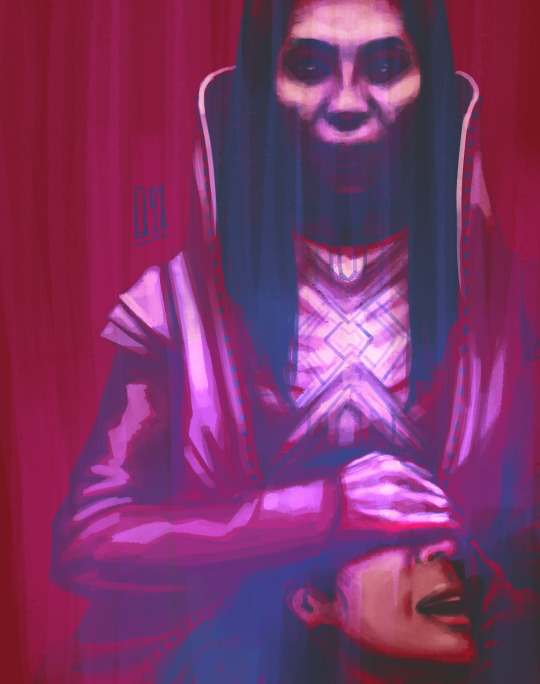
Study after the Emperor's Portrait of Captain Georgiou
[Image description: a red and blue painting of Emperor Georgiou with Philippa Georgiou’s head in her lap. The Emperor is in full imperial regalia, staring impassibly before her. A harsh cold light falls from above on her face, armour and hand, highlighting skull, ribcage and knuckles. Her hand is held over Philippa’s eyes. Philippa is screaming. End description]
#Star Trek Discovery#Star Trek#Philippa Georgiou#Emperor Georgiou#star trek discovery fanart#body horror#kinda#fanart#show: star trek discovery#character: philippa georgiou#character: emperor georgiou#*un autre que moi plays in the background*#I was mucking about during warmup yesterday and it actually turned into something#inspired by Bacon's Study after Velazquez's Portrait of Pope Innocent X#I have no idea why#as I was painting it this just reminded me so much of that particular painting#thinking about him - that screaming pope#this was different but fun#also I made some really dubious coloring choices very early on that I couldn't fix because painting!#I am laughing
43 notes
·
View notes
Text

peter stamatin getting married to a quarter by study after velazquez's portrait of pope innocent x by francis bacon
#my art#and you may say to yourself#how did i get here?#pathologic#peter stamatin#yes im putting it in the tags.#i'm just hands. i have no brain
55 notes
·
View notes
Photo





damned soul by bernini
guernica (detail) by picasso
study after velazquez’s portrait of pope innocent x by bacon
grito nº7 by saura
kanye west by condo
#shoutout to angst gotta be one of my favorite genders#bernini#picasso#francis bacon#antonio saura#george condo#o#n
27 notes
·
View notes
Text
Best Ways to Treat Akathisia That Actually Might Work
Best Ways to Treat Akathisia That Actually Might Work
Left: Diego Velazquez’s Portrait of Pope Innocent X (1650), and, Right: Francis Bacon’s Study After Velazquez’s Portrait of Pope Innocent X (1953).
Akathisia is a great example of the horrors of iatrogenic illness: illness created by medical treatments that never have existed before in human history. The fact that it is so much more excruciating and unimaginable than even cancer and leprosy, and…
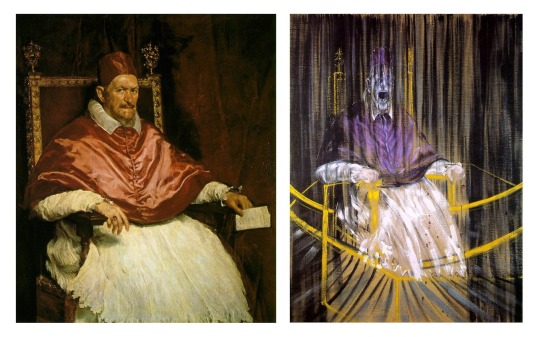
View On WordPress
#acute akathisia treatment#akathisia support#akathisia treatment#akathisia vs anxiety#akathisia withdrawal#alcohol akathisia#anatomy of an epidemic#andrew huberman#antipsychotic-induced akathisia treatment#benzobuddies#beverly thomson#beyondmeds#biohacking#carnivore diet#cbd for akathisia#danny roddy#david healy#dopamine parkinsons#dr. david cohen#dr. jim wright#francis bacon#haidut#holistic medicine#how to stop akathisia#iatrogenic illness#iron#ivan illich#jordan peterson#ken gillman#ketogenic diet
17 notes
·
View notes
Text
i love Francis Bacon's works and they inspire my paintings, although few and far between. the way his work makes me feel is how i aspire to make my own work feel in the future.



picture one: Two Figures - 1953
picture two: Study after Velazquez's portrait of Pope Innocent X (a.k.a. Screaming Pope) - 1953
picture three: Three Studies for Figures at the Base of a Crucifixion - 1944
#francisbacon#francis bacon#painting#traditional art#modern art#expressionism#symbolic painting#symbolic#figurative art#figurative
20 notes
·
View notes